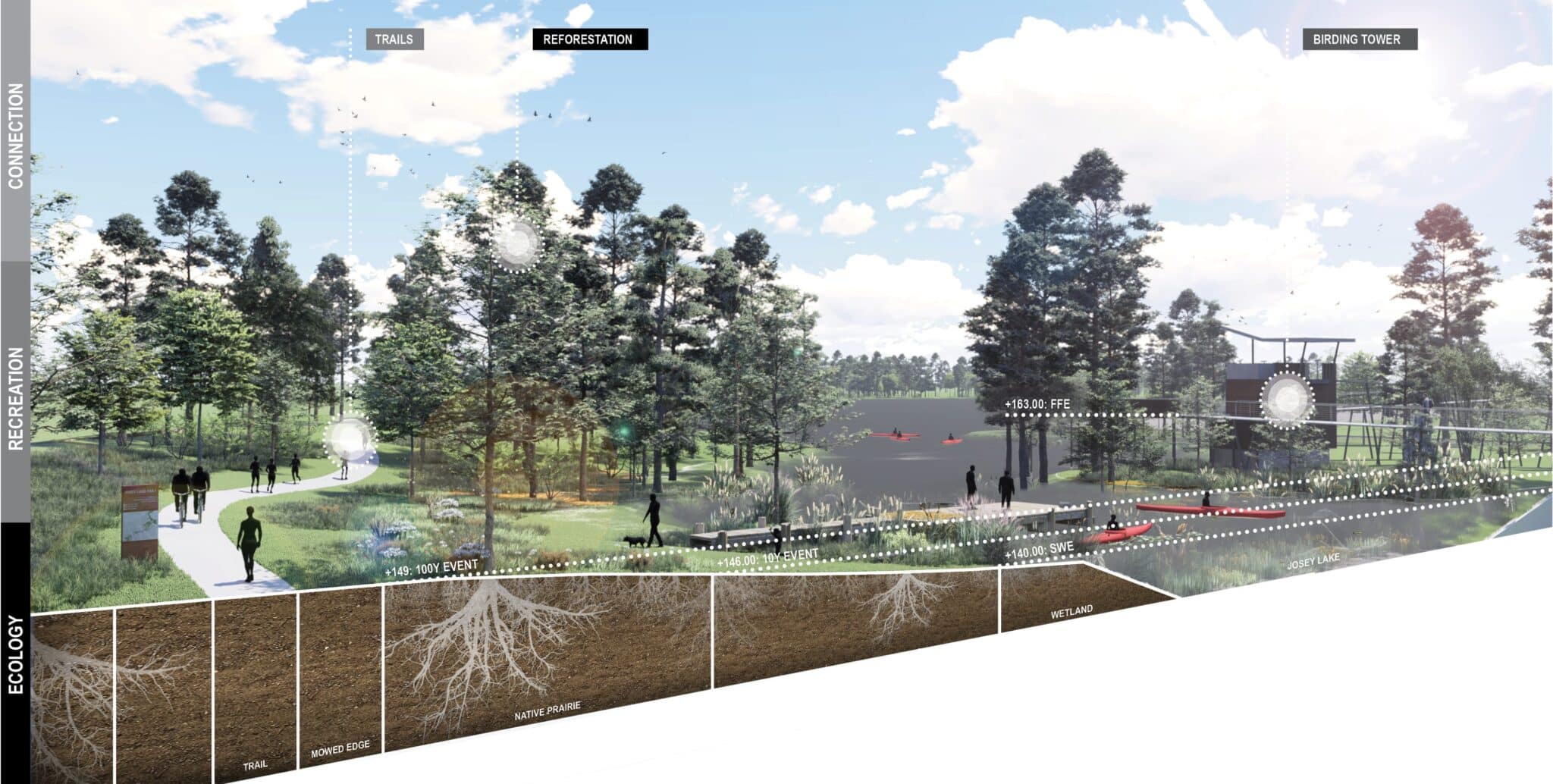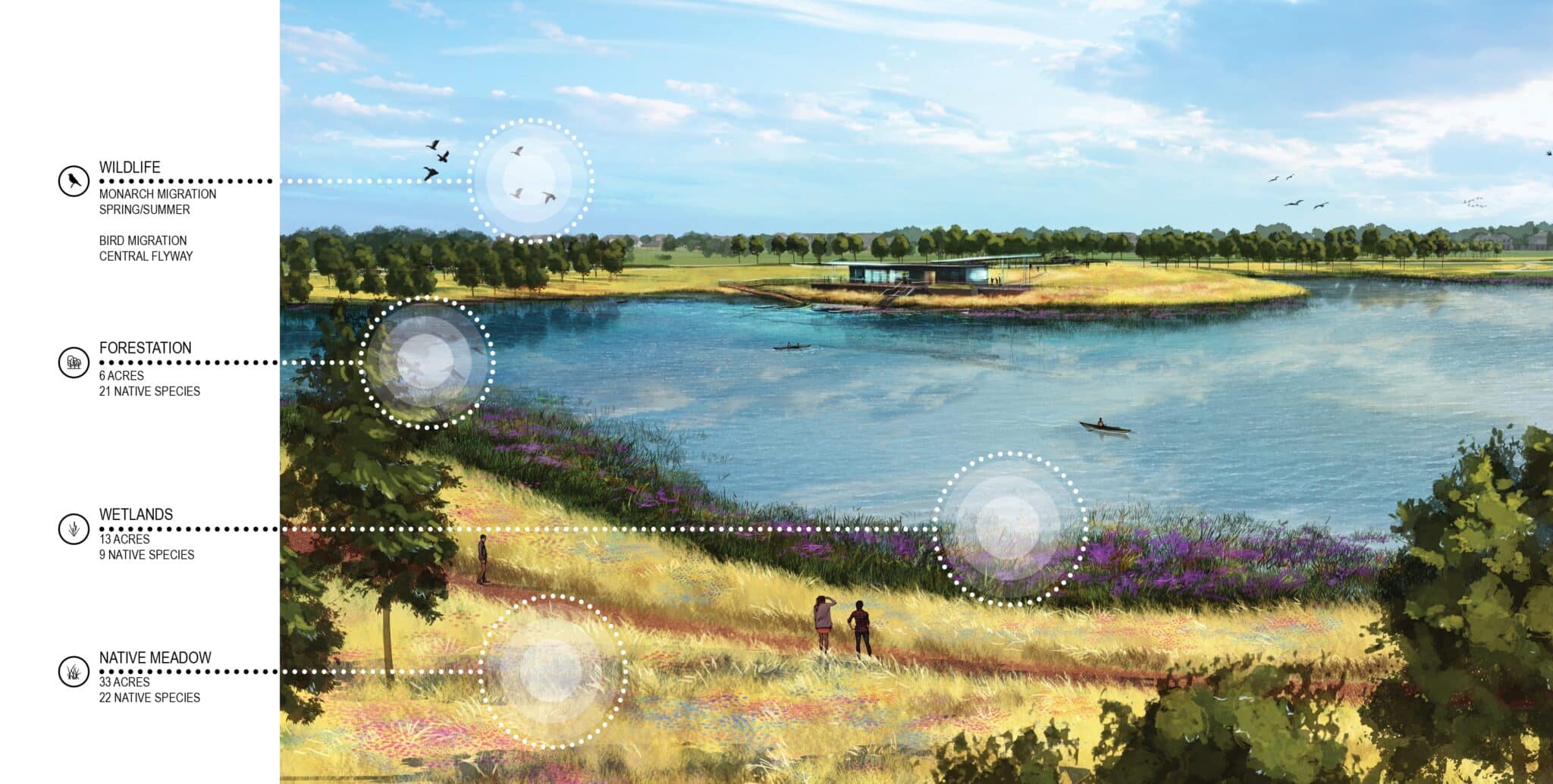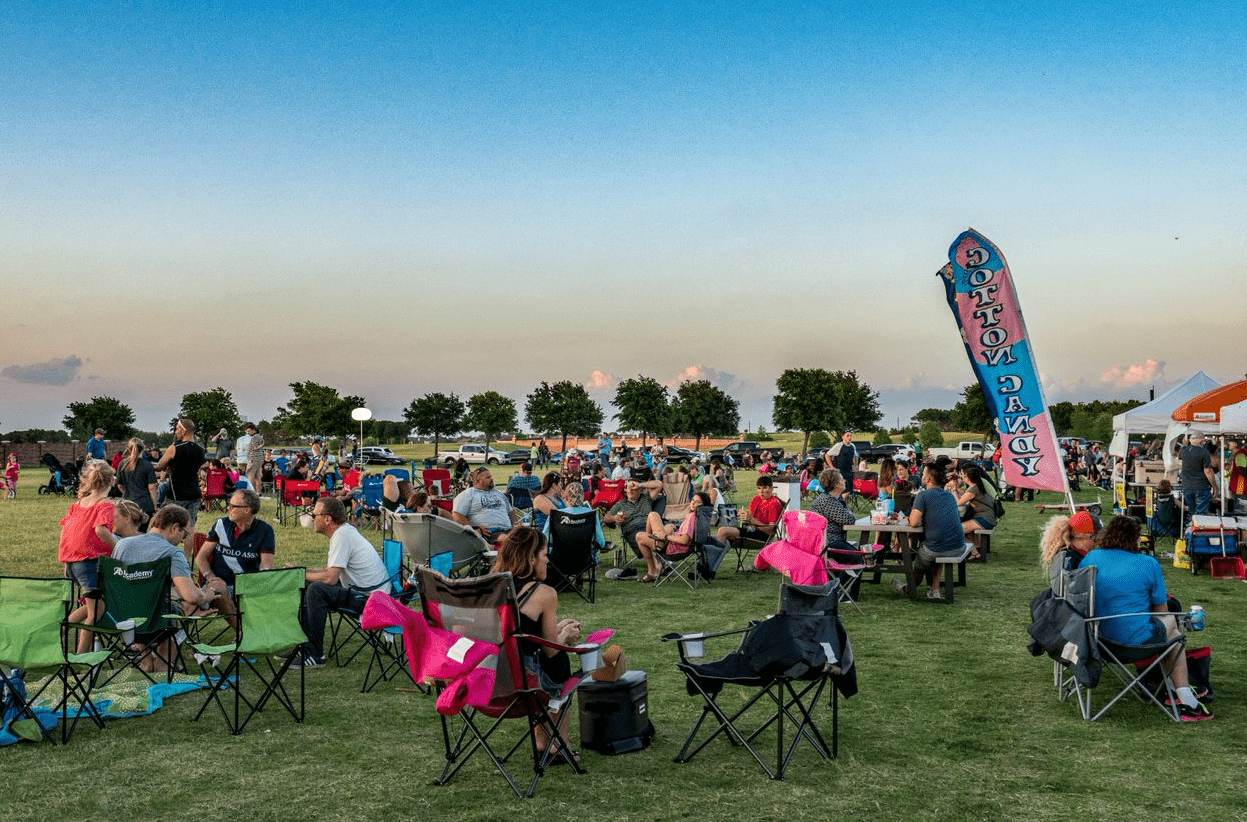CASE STUDY
Transforming A NEcessary Utility into an Iconic Amenity
PROJECT: Josey Lake Park
CLIENT: The Howard Hughes Corporation
LOCATION: Cypress, TX
Josey Lake Park connects users to nature, education, culture and recreation while serving as a highly functional, aesthetic and sustainable stormwater detention system.
CASE STUDY
Transforming A NEcessary Utility into an Iconic Amenity
PROJECT: Josey Lake Park
CLIENT: The Howard Hughes Corporation
LOCATION: Cypress, TX
Josey Lake Park connects users to nature, education, culture and recreation while serving as a highly functional, aesthetic and sustainable stormwater detention system.
The Scene
Bridgeland, an 11,400-acre master planned community in Cypress, Texas, has been successfully implementing its overarching vision to create balance by connecting its residents to nature, education, culture, and recreation. Clark Condon has assisted this client on the design of parks and streetscapes within the community. Josey Lake Park, a 140-acre, regional community park, includes a playground, boardwalks, central lake, birding tower, events pavilion, boat house and various planting typologies layered with active and passive recreational elements. The central and prominent location of the park reinforces the community goals of connectivity and access to recreation, trails, commerce, and schools.

The Project
Josey Lake Park is a signature, recreational greenspace that provides concurrent accessibility to nature and activities while also serving as a regional connector to neighboring communities and commercial developments. While its primary functions are stormwater detention and conveyance infrastructure, the design objective was to take land typically designated for infrastructure and turn it into an exceptional amenity with various ecosystem types and multiple levels of active and passive recreation. Several other items were taken into consideration including long-term maintenance costs, varying ecologies, and wildlife habitat, improving stormwater quality, and providing an area suitable to host community events.
The process
Part of the scope for Josey Lake Park was an Army Corps of Engineers (ACOE) permit to implement enhanced floodwater storage and natural wetland enhancements in a suburban setting. Creative site grading produced very generous slopes which provided ample real estate to accommodate recreational activities both below and above the 100-year flood elevation. Approximately 80% of Josey Lake Park is located below the 100-year flood elevation. In traditional detention systems, these areas are typically void of development. Considering the five, ten and 25-year rainfall event elevations, program elements were strategically placed throughout the site to utilize all available land from the high bank down to the static water elevation.
Through an integrated planting design that respects the various flood level elevations, multiple ecosystems were created ranging from wetlands and grasslands to reforestation. These ecosystems provide a habitat for birds, butterflies, and small wildlife, as well as nonpoint pollution filtering. The design created 13 acres of emergent and submergent wetlands along the shorelines and islands to offer a habitat for aquatic and terrestrial species, water quality polishing and aesthetic enhancement, while also creating a natural setting for public enjoyment. The wetland shelves were planted with noninvasive, native wetland plants which will sustain a habitat for fish, amphibians, aquatic and migratory birds of the Central Flyway. Thirty acres of prairie landscape was recreated using 22 species of native grasses and wildflowers. In time, the native grasses and wildflowers installed in these areas will become a substantive landscape providing food and shelter for prairie wildlife.
Reforestation is the final component to the Josey Lake Park ecosystem. Significant acreage was dedicated to reforestation and close to 2,000 trees were planted outside of the reforestation areas within the park. The tree and reforestation palette include pine, hardwoods, and various understory materials to ensure the mature reforested areas will provide habitat for animals typically found in the Houston region where the piney woods and post oak savannah merge.
The park was also designed to reduce long-term maintenance costs. Upon establishment of the prairie and reforestation plantings, these areas will become regenerative and not require the typical maintenance associated with manicured landscapes. Also, irrigation in these areas can be greatly decreased further reducing regularly irrigated acreage of the park by over 50%.
Given that much of the project is prone to stormwater inundation, there was an inherent need to use resilient materials. Concrete boardwalks, in lieu of traditional wooden boardwalks, traverse wetland shelves and present several overlook opportunities. Accoya wood (a Forest Stewardship Council certified acetylated wood) is used for decking, cladding, soffit, and railing applications and carries a 50-year guarantee. Limestone quarried from west Texas is used throughout the site in a range of applications from building cladding to retaining walls.
The result
Josey Lake Park is an amenity-rich park with ample programming that immerses users in various ecosystems and offers a variety of recreation opportunities. An integrated design approach with the architect resulted in a family of structures that are seamlessly integrated into the landscape. A 23-foot-tall birding tower, 4,750-square-foot boat house and a 3,800-square-foot central pavilion are the main structures on site. The central pavilion anchors a 1.7-acre event lawn and provides covered space and restrooms. Infrastructure was implemented to support food trucks and vendors to serve a multitude of community and private events such as weddings, farmers’ markets, birthday parties and festivals. There are also several outdoor spaces activated with various elements, including a nature playground, ping pong tables, a sculptural fog garden, an amphitheater, and a hammock grove. The playground allows children to engage and play in a non-traditional playground environment. Elevation changes and one-of-a-kind playground elements promote climbing and unique interaction with the surrounding landscape.
With nearly six miles of trails and boardwalks, Josey Lake Park connects to other regional trails and adjacent communities, as well as commercial and retail centers. Park users have the option to utilize the trail system to bypass the busy thoroughfare via two pedestrian underpasses. Additionally, an interpretive signage program was implemented throughout to inform and educate users of the various components of the park and how they fit together to create a symbiotic relationship.
The unparalleled development of Josey Lake Park offers abundant outdoor recreational access to numerous activities while maintaining a harmonious balance with nature. All the amenities, the trail system, waterways, and types of plantings have been carefully chosen not only for aesthetics but to encourage the conservation of resources, wildlife and provide habitat for the numerous species that visit the area. Through careful planning and intentional design, a stormwater detention facility has been amenitized and programmed to create a recreation destination that focuses on ecology, education, and connectivity to benefit humans and wildlife alike.
View Josey Lake park's project profile here.








